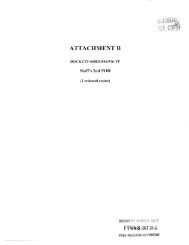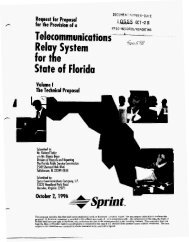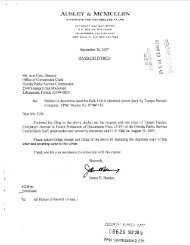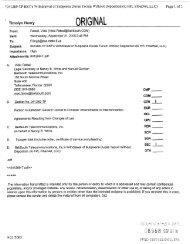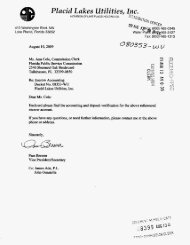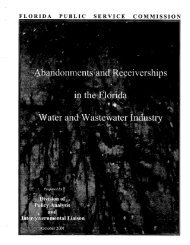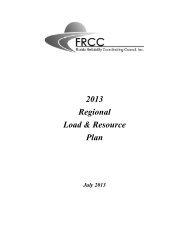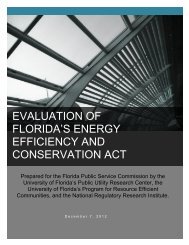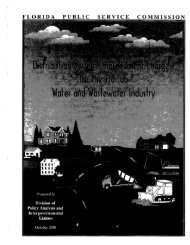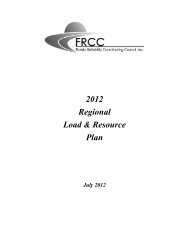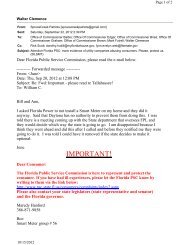- Page 1 and 2:
EXAMPLE August 23,2007 Mr. Jim Gann
- Page 3 and 4:
TABLE OF CONTENTS Cover Letter & In
- Page 5 and 6:
GENERAL INFORMATION In the evcnt th
- Page 7 and 8:
SCOPE AND OTHER REQUIREMENTS I. Bac
- Page 9 and 10:
Appendix B program. The technical d
- Page 11 and 12:
Telephone: Email: (352) 795-0504 x6
- Page 13 and 14:
Summary Report. lhe selected Vendor
- Page 15 and 16:
limitations. Identify the fire prot
- Page 17 and 18:
for receiving bids. WP documents sh
- Page 19 and 20:
Attachment B. Alternatives Analysis
- Page 21 and 22:
PEF Safety Plan PEF-NCR-0060 1
- Page 23 and 24:
TABLE OF CONTENTS SECTION PAGE 1.0
- Page 25 and 26:
1.0 PURPOSE This procedure provides
- Page 27 and 28:
2.0 REFERENCES 2.46 2.47 2.48 2.49
- Page 29 and 30:
4.0 RESPONSIBILITIES 4.1 Site Vice-
- Page 31 and 32:
9.3 General Rules 9.3.5 Red and bla
- Page 33 and 34:
9.4 Personal Safety Protection 9.4.
- Page 35 and 36:
~~ 9.5 Hearing Conservation 9.5.1 9
- Page 37 and 38:
9.9 Lead 9.9.1 Lead removal shall b
- Page 39 and 40:
9.14 Handling, Use, and Storage of
- Page 41 and 42:
9.17 Fall Protection 9.17.1 Fall pr
- Page 43 and 44:
9.19 Scaffolding 9.19.1 All scaffol
- Page 45 and 46:
9.23 Compressed Air Use 9.23.3 Job-
- Page 47 and 48: 9.29 Job Safety Analysis 9.29.1 Job
- Page 49 and 50: ATTACHMENT 1 Sheet 2 of 5 29 CFR 19
- Page 51 and 52: ATTACHMENT 1 Sheet 4 of 5 29 CFR 19
- Page 53 and 54: ATTACHMENT 2 Sheet 1 of 5 HNP Perso
- Page 55 and 56: ATTACHMENT 2 Sheet 3 of 5 HNP Perso
- Page 57 and 58: 191 0.1 36 FOOT PROTECTION ATTACHME
- Page 59 and 60: ATTACHMENT 3 Sheet 2 of 5 RNP Perso
- Page 61 and 62: ATTACHMENT 3 Sheet 4 of 5 RNP Perso
- Page 63 and 64: ATTACHMENT 4 Sheet 1 of 2 HE&EC Per
- Page 65 and 66: ATTACHMENT 5 Sheet 1 of 5 CR3 Perso
- Page 67 and 68: ATTACHMENT 5 Sheet 3 of 5 CR3 Perso
- Page 69 and 70: 1910.136 FOOT PROTECTION ATTACHMENT
- Page 71 and 72: ATTACHMENT 6 Sheet 2 of 2 NGG Hazar
- Page 73 and 74: ~~ ATTACHMENT 8 Sheet 1 of 1 Person
- Page 75 and 76: ~~ ____ Section Description of Chan
- Page 77 and 78: Site Land Use Classification Map PE
- Page 79 and 80: Applicable Sections of the Site Cer
- Page 81 and 82: June 2007 2-2 0738953 1 limits the
- Page 83 and 84: June 2007 1 0738953 SECTION 3 3.0 T
- Page 85 and 86: June 2007 3-2 0738953 1 3.1.1 Descr
- Page 87 and 88: June 7007 3 -4 0738953 I 3.4 Air Em
- Page 89 and 90: June 2007 3 -6 073899 1 emission ra
- Page 91 and 92: June 2007 3-8 0738953 I designed to
- Page 93 and 94: June 2007 3-10 0738953 1 1 1.4 perc
- Page 95 and 96: June 2007 I 0738953 1 SECTION 5 5.0
- Page 97: June 2007 5- 1 0738953 1 5.0 EFFECT
- Page 101 and 102: Figure 2.3.4-5 Once Through Cooling
- Page 103 and 104: Helper Cooling Tower Performance Cu
- Page 105 and 106: Modular Cooling Tower Performance C
- Page 107 and 108: Local Annual Windrose
- Page 109 and 110: 5/24/2007 2 3 7-2 TPA Winter Windro
- Page 111 and 112: 5/24/2007 2.3.7-4 TPA Surnrner Wind
- Page 113 and 114: RFI Number: Discharge Canal Thermal
- Page 115 and 116: Inhattsverzeichnis I Table of conte
- Page 117 and 118: Qu alitats p r u f blattlQuality Te
- Page 119 and 120: Qualit~tsprufbla~Quality Test Sheet
- Page 121 and 122: Kennwort: Job "0: AuRrags-N.: etm m
- Page 123 and 124: QualitSts pr UfblatUQuality I Test
- Page 125 and 126: SIEMENS McdernaalKm prolecf CONFIDE
- Page 127 and 128: SUSQUEHANNA STEAM ELECTRIC STATION
- Page 129 and 130: OTHER LONG TERM RELIABILITY ISSUES
- Page 131 and 132: Figure 1 -Advanced Disc Design LP T
- Page 133 and 134: stainless steel inner casing constr
- Page 135 and 136: Figure 2 - HP Turbine Comparison (U
- Page 137 and 138: ~ ~~ SCOPE OF SUPPLY - HARDWARE SIE
- Page 139 and 140: SIEMENS CONF Mdernaalion Roied PAGE
- Page 141 and 142: SIEMENS co ~N FI DENTI At DO USE 7H
- Page 143 and 144: SIEMENS Modernnation Prolect ADril
- Page 145 and 146: SCOPE OF SUPPLY - HARDWARE SIEMENS
- Page 147 and 148: SIEMENS co Modernizetion Proled ..
- Page 149 and 150:
Moderncalfon Pmpd PAGE5 SCOPE OF SU
- Page 151 and 152:
SIEMENS Modernnebon Propa April 16
- Page 153 and 154:
COMPATIBILITY WITH EXISTING PLANT S
- Page 155 and 156:
SIEMENS Scope of Supply GENERATOR S
- Page 157 and 158:
SIEMENS Mcdemnahon Pnyect Page 3 Ap
- Page 159 and 160:
Supply of Equipment Contracts for n
- Page 161 and 162:
e e Interface with the customer, co
- Page 163 and 164:
CRAFT LABOR EXTRA WORK RATES SIEMEN
- Page 165 and 166:
SIEMENS Modernnabon Projecl Pdge 2
- Page 167 and 168:
SIEMENS Request No SKI22037 Use thi
- Page 169 and 170:
Use rhJ documenr solely for rhe pur
- Page 171 and 172:
SIEMENS ,. ._ - _. . - . . , April
- Page 173 and 174:
a Siemens Contract #I 45569 Work Au
- Page 175 and 176:
iemens Contra roiect Schedule C 0 :
- Page 177 and 178:
ontrac t Sum mar Savings ($000's) A
- Page 180 and 181:
Warranty PEF-NCR-00762
- Page 182 and 183:
Limits of Liability
- Page 184 and 185:
Siemens Contract Summary: 201 I Del
- Page 186 and 187:
0 Siemens Contract Summary: Proiect
- Page 188:
Alstom Initial ProuosalS-ummaw: ..
- Page 191 and 192:
02/28/2607 12:24 412-374-4011 I~ I.
- Page 193 and 194:
Siemens Scope of Supply Comments Ge
- Page 195 and 196:
2P Pg. 1 of 3 iemens Proposal #SD22
- Page 197 and 198:
a Pg. 2 of 3 Turbine Testing: Propo
- Page 199 and 200:
iemens Proposal #SD22007, CR3 Turbi
- Page 201 and 202:
f I Crystal River 3 Generator Cross
- Page 203 and 204:
Siemens Generator Workshop Feb 57,2
- Page 205 and 206:
0 H2 gland seal rings Bearing refur
- Page 207 and 208:
0 Advanced Hydrogen Cooled Stator D
- Page 209 and 210:
February 16,2007 Siemens Power Gene
- Page 211:
OPC ST 1 POD #1 080009 BATES NOS. P
- Page 215 and 216:
Quality Management Manual (QMM 602)
- Page 217 and 218:
Quality Management Manual (QMM 602)
- Page 219 and 220:
Quality Management Manual (QMM 602)
- Page 221 and 222:
Quality Management Manual (QMM 602)
- Page 223 and 224:
Quality Management Manual (QMM 602)
- Page 225:
Quality Management Manual (QMM 602)
- Page 228 and 229:
Progress Energy Florida, Inc. Cryst
- Page 230 and 231:
GENERAL INFORMATION In the event th
- Page 232 and 233:
SCOPE AND OTHER REQUIREMENTS I. Bac
- Page 234 and 235:
Appendix B program. The technical d
- Page 236 and 237:
Telephone: Email: (352) 795-0504 x6
- Page 238 and 239:
Summary Report. The selected Vendor
- Page 240 and 241:
limitations. Identify the fire prot
- Page 242 and 243:
for receiving bids. RFP documents s
- Page 244 and 245:
1. 2. 3. 4. 5. 6. Attachment 6. Alt
- Page 246 and 247:
PEF Safety Plan 18
- Page 248 and 249:
Applicable Sections of the Site Cer
- Page 250 and 251:
Helper Cooling Tower Performance Cu
- Page 252 and 253:
Local Annual Windrose 24
- Page 254 and 255:
April 10, 2008 Attn: Subject : Prog
- Page 256 and 257:
ACKNOWLEDGEMENT To: Deborah Hanna P
- Page 258 and 259:
Contractor's License Number (if app
- Page 260 and 261:
schedule for the Project’s implem
- Page 262 and 263:
. 3 90 O F Design Outlet Temperatur
- Page 264 and 265:
0 Projected EAC 0 Accomplishments 0
- Page 266 and 267:
October 13,2006 AR WA-06-2792 Mr. D
- Page 268 and 269:
AREVA NP InC. Proposal #4 161084 PR
- Page 270 and 271:
AREVA NP Inc. Proposal #4167084 - E
- Page 272 and 273:
AREVA NP Inc. Proposal #4161084 PRO
- Page 274 and 275:
AREVA NP Inc. Proposal #416 1084 PR
- Page 276 and 277:
AREVA NP Inc. Proposal #4161084 PRO
- Page 278 and 279:
AREVA NP Iflc. Proposal #4161084 PR
- Page 280 and 281:
CR-3 Power Uprate Project a Progres
- Page 282 and 283:
AREVA NP Inc. Proposal #4767084 PRO
- Page 284 and 285:
AREVA NP lnc. Proposal #4161084 PRO
- Page 286 and 287:
AREVA NP Inc. Proposal #4 161084 PR
- Page 288 and 289:
AREVA Inc. Proposal #4161084 PROPRI
- Page 290 and 291:
AREVA Inc. Proposal#4161084 PROPRIE
- Page 292 and 293:
CR-3 Power Uprate Project 20 Progre
- Page 294 and 295:
AREVA Inc. Proposal #4 161084 PROPR
- Page 296 and 297:
AREVA Inc. Proposal #4161084 PROPRI
- Page 298 and 299:
AREVA Inc. Proposal #4 I6 7084 PROP
- Page 300 and 301:
CR-3 Power Uprate Project 28 Ppgres
- Page 302 and 303:
AREVA Inc. Proposal #47 61084 PROPR
- Page 304 and 305:
AREVA Inc. Proposal #4161084 PROPRI
- Page 306 and 307:
AREVA Inc. Proposal #4167084 PROPRI
- Page 308:
A REVd inc. Proposal #47 67084 PROP
- Page 311 and 312:
AREVA NP Inc P ROPRl ETARY - PENG07
- Page 313 and 314:
ktum this Propsat, If requested. Pa
- Page 315 and 316:
AREVA NP inc PROPRl ETARY PENG07-13
- Page 317 and 318:
OPC 1 st POD #1 080009 BATES NOS. P
- Page 319 and 320:
SIEMENS Modernnabon Pwnf Apnl 16 xx
- Page 321 and 322:
I .- . -.. .,. Awl 16. 2007 Pqress
- Page 325 and 326:
w a
- Page 327 and 328:
SIEMENS Mcdwnaafion Roj& April 16,
- Page 329 and 330:
SIEMENS PAOE 2 Semens Confidential
- Page 331 and 332:
Mcdernuabon Projecl PPQE4 Generala
- Page 333 and 334:
Modernnabon hied Apnll6, XO7 PAGE6
- Page 335 and 336:
SEMENS Mcdernaabon proled Aprrl 16.
- Page 337 and 338:
SIEMENS McdwnrzeOon Prolecl PAOE 10
- Page 339 and 340:
MODERNIZED EXPERIENCE LIST SIEMENS
- Page 341 and 342:
MODERNIZED EXPERIENCE LIST SIEMENS
- Page 343:
SIEMENS
- Page 349 and 350:
-1 F: i= Lu P w
- Page 351 and 352:
All requests for clarifications, in
- Page 353 and 354:
GENERAL IhTORMATION PROGRESS ENERGY
- Page 355 and 356:
SCOPE AND OTHER REOUIREMENTS PROGRE
- Page 357 and 358:
sizc or quantity. Further, in the e
- Page 359 and 360:
Schedule Risk: agreement to h ish s
- Page 361 and 362:
..ll-.l-l_l..--l.-l-- I - Progress
- Page 363 and 364:
OPC ST 1 POD #1 080009 BATES NOS. P
- Page 365 and 366:
Spec Page Crystal River Unit 3 Nucl
- Page 367 and 368:
Spec Page # Nuclear Power Station R
- Page 369 and 370:
Spec Page I Crystal River Unit 3 Nu
- Page 371 and 372:
Section Reference Replacement Turbi
- Page 373 and 374:
Crystal River Unit 3 Nuclear Power
- Page 376 and 377:
Crystal River Unit 3 Nuclear Power
- Page 378 and 379:
Section Reference 1.11.11 1.11.12 1
- Page 380 and 381:
Crystal River Unit 3 Nuclear Power
- Page 382 and 383:
Section Reference / d Crystal River
- Page 384 and 385:
Spec Page # Crystal River Unit 3 Nu
- Page 386 and 387:
~ Spec Page # 29 _. 29 - 29 - 29 29
- Page 388 and 389:
~ - Spec Page # 'I Crystal River Un
- Page 390 and 391:
spec Page # Section Reference Cryst
- Page 392 and 393:
Spec Page # Section Reference I I C
- Page 394:
t E E, 0 0 z c n 6 e h I1 n
- Page 397 and 398:
f c ALST6)M I Power Systems May 30,
- Page 399 and 400:
Alstom Power Inc. 2800 Waterford La
- Page 401 and 402:
” . . v 111 Crystal River Nuclear
- Page 403 and 404:
c Commercial Volume (U n pr iced) 2
- Page 405 and 406:
Alstom Proposal # SD22007, CR3 EPU
- Page 407 and 408:
Alstom Proposal # SD22007, CR3 EPU
- Page 409 and 410:
Alstom Proposal # SD22007, CR3 EPU
- Page 411 and 412:
Alstom Proposal # SD22007, CR3 EPU
- Page 413 and 414:
I ' Our proposal offers a strong te
- Page 415 and 416:
ENERCON SERVICES, INC. Proprietary
- Page 418 and 419:
ENERCON SERVICES, INC. 5.0 ORGANIZA
- Page 420 and 421:
CR3 Extended Power Uprate, Secondar
- Page 422 and 423:
CR3 Extended Power Uprate, secondar
- Page 424 and 425:
CR3 Extended Power Uprate, Secondar
- Page 426 and 427:
September 4,2007 Page 2 Addendum to
- Page 429:
CONFIDENTlF.? September 4,2007 Page
- Page 437:
CONFIDEMTIP,!.
- Page 445 and 446:
Daie TU; 9/4/07 Milestone Project S
- Page 447:
1 Dace Tue 9/4/07 Milestone Prqed S
- Page 453 and 454:
D Computer Model Updates o PEPSE- h
- Page 455 and 456:
D D D D D D D Feedwater Control Val
- Page 458 and 459:
D AREVA has full time employees wit
- Page 460 and 461:
I W
- Page 462 and 463:
~ AREVA - has a proven track record
- Page 464 and 465:
Per the reement #I 01659, the LOL c
- Page 466 and 467:
CR3 Extended Power Uprste, Secondar
- Page 468 and 469:
. - * CR3 Extended Power Umate, Sec
- Page 470 and 471:
(IHJ i3dendecl I'ower Ulirate, Seco
- Page 473 and 474:
CONFIDENTlP!-
- Page 475:
a CONFIDENTIP.!m PEF-NCR-01659
- Page 480 and 481:
PROPRIETARY 20440-1 2 f3/30/2006) T
- Page 482 and 483:
-- AREVA NP Inc. PROPRIETARY a CONF
- Page 484 and 485:
July 27,2005 PROGRESS ENERGY SERVIC
- Page 486 and 487:
Attachment A to Request No. KS12007
- Page 488 and 489:
.. Clarlflcation on the 1CS system:
- Page 490 and 491:
June 6,2007 Attention : PROGRESS EN
- Page 492 and 493:
ACKNOWLEDGEMENT Mr. Tony Owen Progr
- Page 494 and 495:
In accordance with the Federal Acqu
- Page 496 and 497:
SCOPE AND OTHER REOUIREMENTS PROGRE
- Page 498 and 499:
place in the proposal at the expens
- Page 500 and 501:
other information provided in its p
- Page 502 and 503:
a ProgressEnergy Contractor's Safet
- Page 504 and 505:
1 P96 I O-XJN-d3d
- Page 506 and 507:
~ ____, Crystal River Unit 3 Nuclea
- Page 508 and 509:
Progress Energy Crystal River Unit
- Page 510 and 511:
Progress Energy Crystal River Unit
- Page 512 and 513:
Progress Energy Crystal River Unit
- Page 514 and 515:
Progress Energy Crystal River Unit
- Page 516 and 517:
Progress Energy Crystal River Unit
- Page 518 and 519:
Progress Energy Crystal River Unit
- Page 520 and 521:
Progress Energy Crystal River Unit
- Page 522 and 523:
Progress Energy Crystal River Unit
- Page 524 and 525:
Progress Energy Crystal River Unit
- Page 526 and 527:
Progress Energy Crystal River Unit
- Page 528 and 529:
P Progress Energy Crystal River Uni
- Page 530 and 531:
Progress Energy Crystal River Unit
- Page 532 and 533:
Progress Energy Crystal River Unit
- Page 534 and 535:
Progress Energy Crystal River Unit
- Page 536 and 537:
Progress Energy Crystal River Unit
- Page 538 and 539:
Progress Energy Crystal River Unit
- Page 540 and 541:
Progress Energy Crystal River Unit
- Page 542 and 543:
Progress Energy Crystal River Unit
- Page 544 and 545:
Progress Energy Crystal River Unit
- Page 546 and 547:
Progress Energy Crystal River Unit
- Page 548 and 549:
Progress Energy Crystal River Unit
- Page 550 and 551:
Progress Energy Crystat River Unit
- Page 553 and 554:
April 10,2008 PROGRESS ENERGY SERVI
- Page 555 and 556:
Attachment A to Request No. KS12007
- Page 557 and 558:
Clarification on the ICs system: At
- Page 559 and 560:
CR3 Extended Power Uprate, Secondar
- Page 561 and 562:
CR3 Extended Power Uprate, Secondar
- Page 563 and 564:
Proposal for Design Engineering of
- Page 565 and 566:
Tech Com International 440 Goddard
- Page 567 and 568:
Tech Com International 440 Goddard
- Page 569 and 570:
Tech Coin International 440 Goddard
- Page 571 and 572:
Tech Com International 440 Goddard
- Page 573 and 574:
~ ~~~ Tech Com Intern ation a1 440
- Page 575 and 576:
Tech Com International 440 Goddard
- Page 577 and 578:
~~~ ~ ~ ~~ ~ ~~~ ~ Tech Com Interna
- Page 579 and 580:
PEF-NCR-02039
- Page 581 and 582:
Spec Page tt section Reference Crys
- Page 583 and 584:
Comments I 1 I I I I I I I and 18 t
- Page 585 and 586:
Spec Page # Mion Reference Crystal
- Page 588 and 589:
N B 00
- Page 590 and 591:
CR3 Extended Power Uprate, Secondar
- Page 592 and 593:
CR3 Extended Power Uprate, Secondar
- Page 594 and 595:
.. CR3 Extended Power Uerate, Secon
- Page 596 and 597:
Mr. Tony Owen Progress Energy Augus
- Page 610 and 611:
JOB NO. PROPOSAL "RADIUSED HOLE" MS
- Page 613 and 614:
ARRANGEMENT FOR STACKING AND JACKIN
- Page 617 and 618:
a CONFIDENTlrl!
- Page 619 and 620:
n a. TlEi Document Number: 07-924 P
- Page 621 and 622:
1. Outline Drawings ....... 19 2. D
- Page 623 and 624:
OPC ST 1 POD 080009 BATES NOS. PEF-
- Page 625 and 626:
‘El Contract Summary on tents: a
- Page 627 and 628:
TEI Contract Summary Payment Milest
- Page 630 and 631:
TEI Contract Summary Performance Li
- Page 632:
REDACTED Corrective Measures: - - -
- Page 635 and 636:
'El Contract Sumrr iar roject Revie
- Page 637 and 638:
Document Number: 07-248 Proposal Nu
- Page 639 and 640:
Page 4.0 TECHNICAL 4.1 Performance
- Page 641 and 642:
Finally, this unsolicited proposal
- Page 643 and 644:
1. 2. 3. 4. 5. 6. 7. 8. On the spot
- Page 645 and 646:
The TEI resources provisions are: a
- Page 649 and 650:
4.0 TECHNICAL 4.1 Performance The p
- Page 651 and 652:
8. The 4-pass box redesign assures
- Page 653 and 654:
The design incorporates the state-o
- Page 655 and 656:
e e e A higher structural integrity
- Page 657 and 658:
4.4 MSR Performance Tests 4.4.1 Sco
- Page 660:
n .L a W 2
- Page 668 and 669:
Lfl CONFIDENTIFr!. JOB NO. PROPOSAL
- Page 670 and 671:
PROPOSAL FUNCTION OF BY-PASS RESTRI
- Page 674 and 675:
-1 r. m N N ? e: ? w" a
- Page 676 and 677:
a CONFIDENTIAL PEF-NCR-02239



